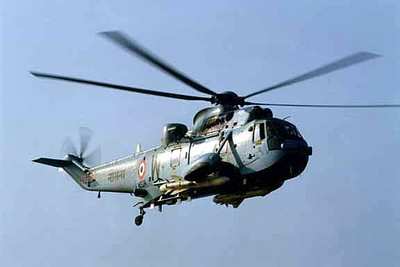Wed, Feb 09, 2005
1998 Embargo Lifted on Harrier, Sikorsky SH-3 Parts
The Indian Navy's Sea Harrier and SH-3 helicopter fleets have
suffered serious spare parts availability problems since the US
imposed sanctions after India's 1998 nuclear test. At times, as
many as 30 to 40-percent of Indian aircraft have been grounded
because of the spares shortages, according to Indian Navy Vice
Chief of Naval Staff Admiral John DeSilva.

The Sea Harriers are the Navy's only combat airplanes, providing
fleet defense and striking power; the Sea King helicopters are
vital to protecting India's growing fleet from hostile submarines.
The Sea Kings are American Sikorsky machines, and the Harriers were
built by an Anglo-American partnership and incorporate many
American components that require periodic servicing.

The word "sanctions" makes everyone think of a total embargo,
but in this case supply was never completely cut off. Instead,
Indian procurement officers had to work through British
intermediaries who had to get individual authorizations to
re-export United States-sourced products to India. This took time
and added a lot of "hurry up and wait" to the Indian naval-aviation
supply system.
While the Indian officers welcome the ability to buy direct,
rather than endure indirect and unresponsive supply lines, the
sanctions experience has made them leery of the USA as a supplier.
The US, however, has three desires: one, to reward India for its
cooperation in the war, which continues out of the public eye; two,
to continue the improvements in bilateral relations begun in 2001;
three, and perhaps most important, to gain a toehold in the growing
Indian arms market.

India's traditional arms suppliers, Russia and France, can
supply many things, but not advanced VSTOL aircraft that will
follow the Harrier in US and European service. The US for its part
would welcome another partner to share the cost -- and the risk --
for the V-35 VSTOL variant. Despite the definite differences
between these nations, the common interests of these two populous
and well-established free nations will continue to bring them
together.
More News
Back-Taxi A term used by air traffic controllers to taxi an aircraft on the runway opposite to the traffic flow. The aircraft may be instructed to back-taxi to the beginning of the>[...]
“Our WAI members across the nation are grateful for the service and sacrifice of the formidable group of WASP who served so honorably during World War II. This group of brave>[...]
“Many aspiring pilots fall short of their goal due to the cost of flight training, so EAA working with the Ray Foundation helps relieve some of the financial pressure and mak>[...]
Blind Speed The rate of departure or closing of a target relative to the radar antenna at which cancellation of the primary radar target by moving target indicator (MTI) circuits i>[...]
Aero Linx: International Airline Medical Association (IAMA) The International Airline Medical Association, formerly known as the Airline Medical Directors Association (AMDA) was fo>[...]
 ANN's Daily Aero-Term (05.19.24): Back-Taxi
ANN's Daily Aero-Term (05.19.24): Back-Taxi Aero-News: Quote of the Day (05.19.24)
Aero-News: Quote of the Day (05.19.24) Aero-News: Quote of the Day (05.20.24)
Aero-News: Quote of the Day (05.20.24) ANN's Daily Aero-Term (05.20.24): Blind Speed
ANN's Daily Aero-Term (05.20.24): Blind Speed ANN's Daily Aero-Linx (05.20.24)
ANN's Daily Aero-Linx (05.20.24)





